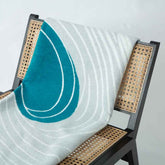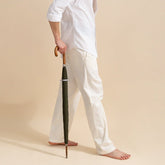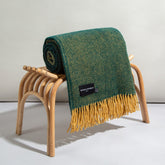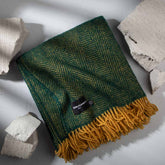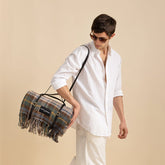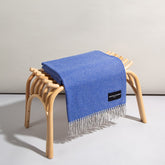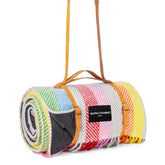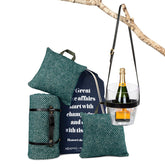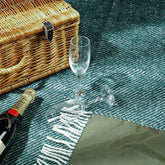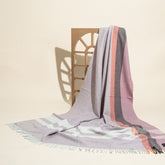How Wool Blankets are Made: An Inside Look at the Process
Ever wondered how wool blankets are made? From the soft fleece of a sheep to the cozy throw on your sofa, the journey of a wool blanket is both fascinating and rooted in centuries of tradition. Understanding the process helps us appreciate not just the warmth and comfort of these blankets—but also the craftsmanship, natural materials, and sustainability behind them.
In this article, we’ll take you step-by-step through how wool is made into a blanket: starting with shearing the sheep, then cleaning, spinning, weaving, and finally finishing the fabric into the luxurious wool throws we love today. So, wrap yourself in your favourite wool throw, settle in, and join us as we delve into the fascinating process behind making a wool blanket.
Key Takeaways: How Wool Blankets Are Made
-
The process starts with shearing: Skilled shearers carefully remove the fleece without harming the sheep. This is a necessary part of sheep care and the first step in producing wool.
-
Wool is thoroughly cleaned (scoured): After shearing, the raw fleece is washed to remove lanolin, dirt, and debris, leaving behind clean, fluffy wool ready for processing.
-
Carding and spinning transform wool into yarn: Wool fibres are combed and aligned through carding, then spun into yarn using traditional or modern spinning machines.
-
Blankets are woven on a loom: The spun yarn is interlaced using warp and weft threads, creating a durable and warm fabric with texture and strength.
-
Finishing touches improve texture and durability: After weaving, wool blankets are washed, fulled (lightly felted), napped (brushed for softness), and inspected for quality.
-
Ethical and sustainable practices matter: Responsible wool production involves animal welfare, low-waste manufacturing, and biodegradable materials, making wool blankets a natural and eco-friendly choice.
Overview of the Wool Production Process
The journey of a wool blanket starts far from the weaving looms and textile mills. It begins in the peaceful pastures where sheep graze and grow their dense, warm coats. Let's walk through the first crucial steps of the wool production process: shearing and cleaning.

Shearing the Sheep
Shearing is the process of removing wool from the sheep, and it is an activity that requires skill and care. Skilled shearers use special clippers to remove the fleece without harming the animal. It's a careful dance, a balance of keeping the sheep calm while also ensuring a clean, even cut. Done properly, shearing is harmless to the sheep and actually necessary for their health and comfort, particularly in warmer months.
Once shorn, the wool, known as a fleece, is rolled and stored in a clean, dry area, awaiting the next steps in the process.
Cleaning the Wool
After shearing, the wool is not yet ready to be spun into yarn. It must first go through a process known as scouring, which is essentially a thorough cleaning process. Raw fleece contains not just wool, but also natural sheep oils (lanolin), sweat residues, dirt, and sometimes a bit of plant material.
In the scouring process, the fleeces are washed in large vats of warm water with a mild detergent. This washing process removes the impurities and leaves behind clean, fluffy wool that's ready for the next stage: carding and spinning into usable yarn.
In our next section, we'll delve into these processes and explain how raw wool transforms into the cozy yarn that will eventually make up our wool blanket. The journey is just beginning, and it's already clear that the creation of a wool blanket is a process steeped in skill, care, and respect for nature's bounty.
From Raw Wool to Usable Yarn
Once the wool is cleaned and dried, it's time to transform those fluffy piles into a material that can be woven into a blanket. This journey takes us through the process of carding and spinning, which are crucial for creating high-quality, durable wool yarn.
Carding the Wool
Carding is the process of combing the wool fibres to align them and prepare them for spinning. The wool is fed into a carding machine, which consists of drums covered in tiny wire hooks. As the drums rotate, they pull the wool apart, separating and straightening the fibres. The end product is a loose rope of fibres called a roving.
Carding not only detangles the wool and aligns the fibres, but it also removes any remaining impurities. It ensures that the wool is as clean and uniform as possible before it's spun into yarn.
Spinning the Wool
Once carded, the wool rovings are ready to be spun into yarn. The roving is fed into a spinning machine, where it's twisted and wound onto bobbins. The amount of twist the yarn receives affects its strength, texture, and appearance.
Wool yarn can be spun in different thicknesses and plys, depending on the desired outcome. For blankets, a thicker, multi-ply yarn might be used to ensure warmth and durability.
At this stage, the wool has been transformed from a raw, untidy fleece into clean, neatly wound yarn, ready to be woven into a blanket. The process, though complex, lays the foundation for the quality and comfort of the final product - a wool blanket.
In the next section, we'll delve into the weaving process, the heart of making a wool blanket, and show how individual strands of yarn become a unified, cozy fabric. The process of making a wool blanket, as we're discovering, is not just about creating a product - it's a testament to the blend of tradition, technology, and craftsmanship.
The Weaving Process
Now that we've got our wool yarn, it's time to begin the weaving process. This is where individual threads interlace to form the whole fabric of the blanket. The loom plays a crucial role in this process, as it holds the threads in place and facilitates their intertwining.
The Role of the Loom
A loom is a device used to weave cloth by holding threads under tension while other threads are interlaced at right angles to them. Traditional handlooms and high-speed industrial looms follow the same basic principle, though the scale and speed vary greatly.

The threads that run lengthways on the loom are known as the warp. These are held under tension and provide the structure for the fabric. The threads that interlace through the warp at right angles are known as the weft. Together, the warp and the weft create the woven fabric.
Weaving
Weaving begins by setting up the loom with the warp threads. This is a meticulous task, as each thread must be correctly aligned and tensioned. The number of warp threads can run into thousands, depending on the width and density of the blanket to be produced.
Once the loom is set up, the weaving process can begin. The loom works by lifting certain warp threads while others remain in place. The weft thread is then passed through the gap, known as the shed, created by the lifted warp threads. This interlacing of warp and weft threads creates the woven fabric.
The pattern, tightness, and texture of the weave can all be controlled during this process. For wool blankets, a tighter weave is often used to create a denser, warmer fabric.
At the end of the weaving process, we're left with a large piece of woven wool fabric, but it's not a blanket just yet. In our next section, we'll cover the finishing touches that transform this woven fabric into a soft, cozy, and long-lasting wool blanket. As we're discovering, each step in the process adds another layer of quality and character to the final product.
The Finishing Touches
After emerging from the loom, the wool fabric is technically a blanket, but there are still a few steps left before it becomes the cozy, durable, and aesthetically pleasing product we're familiar with. The finishing process involves several key stages that refine the texture, appearance, and warmth of the wool blanket.
Washing the Wool Blanket
First, the newly woven wool blanket undergoes a washing process. Washing removes any residual oils or dirt and helps to fluff up the wool fibers, creating a softer and loftier texture. The water temperature and washing method are carefully controlled to prevent shrinkage or distortion of the fabric.
Fulling the Wool Blanket
Next comes the fulling process, also known as felting. Fulling involves exposing the wool blanket to moisture, heat, and agitation. This process causes the wool fibres to shrink slightly and become more densely packed together, enhancing the blanket's warmth and durability.
A fulled wool blanket has a thicker, more luxurious feel compared to a non-fulled one. It's also more resistant to wind and water, making it an ideal choice for outdoor use.
Napping the Wool Blanket
The final step in the finishing process is napping. Napping involves brushing the surface of the wool blanket with a specialised machine to raise the surface fibres, creating a fluffier, softer texture.
A well-napped wool blanket has a plush, velvety feel that's incredibly comforting against the skin. It also enhances the blanket's insulating properties, making it even warmer.
Quality Check
After the blanket has been finished, it goes through a rigorous quality check. Each blanket is inspected for any flaws or defects. The thickness, dimensions, and weight of the blanket are all checked to ensure they meet the company's standards.
Only after passing the quality inspection does the wool blanket get packaged and prepared for shipment or sale. The care taken at this stage ensures that each wool blanket is a high-quality product that will provide warmth and comfort for many years to come.
Sustainability and Ethical Considerations
The journey of a wool blanket from sheep to your home is a complex and meticulous process, and it's crucial that this process also respects the environment and the welfare of the sheep. Thankfully, the wool industry has made significant strides in prioritizing sustainable and ethical practices.
Sustainable Wool Production
Sustainable wool production begins with the care and management of the sheep. This includes practices like rotational grazing, which helps to maintain soil health and biodiversity. Additionally, sustainable wool production considers the entire lifecycle of the product, seeking ways to reduce waste and energy use at every stage.
Recycling and reusing wool products is a significant aspect of this approach. Wool is a natural, biodegradable material, and old wool blankets can be recycled into new products, reducing the demand for new wool.
Ethical Wool Production
Ethical wool production primarily concerns the treatment of the sheep. This includes ensuring that the sheep are shorn in a stress-free environment, have access to plenty of pasture, and receive appropriate veterinary care.
Many wool producers are now certified by animal welfare standards such as the Responsible Wool Standard (RWS), which assures consumers that the wool they are buying comes from farms with a progressive approach to managing their land, and from sheep that have been treated responsibly.
FAQ
How are wool blankets made?
Wool blankets are made through a multi-step process that begins with shearing sheep to collect raw fleece. The wool is then cleaned (scoured), carded to align the fibres, and spun into yarn. This yarn is woven into fabric using a loom. After weaving, the fabric undergoes finishing processes like fulling (a type of controlled shrinkage), napping (brushing for softness), and quality checks before becoming a finished wool blanket.
What is the process of making wool?
The process of making wool starts with shearing sheep, followed by washing (scouring) to remove oils and dirt. The clean wool is then carded, which separates and aligns the fibres. After carding, the wool is spun into yarn and either dyed or left natural. This yarn can then be woven into textiles such as blankets, clothing, or upholstery.
How is wool cleaned before use?
Wool is cleaned using a method called scouring. This involves soaking the raw fleece in warm water and mild detergent to remove lanolin (natural oils), dirt, sweat, and plant material. Multiple rinses ensure the wool is thoroughly cleaned before it's dried and prepared for spinning.
What is fulling in wool blanket production?
Fulling is a finishing process that slightly felts the wool fabric by applying heat, moisture, and agitation. This causes the fibres to interlock more tightly, increasing the blanket’s thickness, warmth, and resistance to wind and moisture. It also enhances the durability and longevity of the final product.
Are wool blankets sustainable?
Yes, wool blankets are highly sustainable. Wool is a renewable, biodegradable natural fibre that requires less energy to produce than synthetic materials. Responsible farms also follow ethical practices such as rotational grazing and humane treatment of sheep, often certified by standards like the Responsible Wool Standard (RWS).
What makes wool blankets different from other types?
Wool blankets are known for their natural insulation, breathability, and moisture-wicking properties. Unlike synthetic blankets, wool regulates temperature effectively and is naturally flame-resistant. They also tend to last longer when properly cared for and offer a premium tactile experience with minimal environmental impact.



























